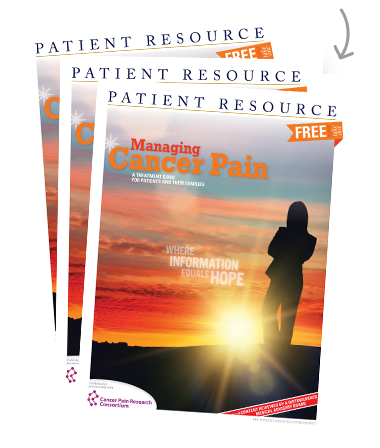Pain
Defining cancer-related pain
 Cancer-related pain is caused by several different factors; in most cases it is directly related to the cancer itself and the location of the tumor(s). As a tumor grows, it can press on internal organs, tissues and joints, creating pressure that ultimately leads to pain in that specific area. Pain can also be caused by cancer that has spread to bone. This pain is typically felt in the back, pelvis and hips, as these bones are the most common sites of cancer spread (metastasis). Cancer-related pain may be felt in parts of the body other than where the primary tumor is located, especially in advanced disease.
Cancer-related pain is caused by several different factors; in most cases it is directly related to the cancer itself and the location of the tumor(s). As a tumor grows, it can press on internal organs, tissues and joints, creating pressure that ultimately leads to pain in that specific area. Pain can also be caused by cancer that has spread to bone. This pain is typically felt in the back, pelvis and hips, as these bones are the most common sites of cancer spread (metastasis). Cancer-related pain may be felt in parts of the body other than where the primary tumor is located, especially in advanced disease.
In addition to cancer-specific pain, diagnostic procedures and treatments, including surgery, chemotherapy and radiation therapy, may cause different types of pain. After surgery, pain is usually felt in the area of the surgery. This pain will gradually lessen as the body heals and recovers. The pain or discomfort caused by chemotherapy and radiation therapy can be mild to severe, but often (although not always) ends when treatment does. Sometimes, a hormone imbalance or treatment-related nerve damage may contribute to chronic pain.
Types of pain
Doctors refer to pain in three categories: nociceptive somatic, nociceptive visceral and neuropathic. These terms seem complicated, but their meaning can be simplified. Nociceptive pain arises when nerve cells (called nociceptors) are stimulated to send pain signals by some kind of ongoing injury, such as pressure by a tumor or the cut of a surgical scalpel. Pain caused by stimulation of nerve cells in soft tissues or muscles is defined as nociceptive somatic; pain caused by stimulation of nerve cells in body organs is defined as nociceptive visceral. Neuropathic pain is caused by damage to nerves, causing these nerves to send pain signals even though there isn’t ongoing injury. Each of these categories of pain has distinct causes (see Table 1). Pain is also defined by its timing.
- Acute pain is pain that occurs suddenly; it is sometimes related to a diagnostic procedure or treatment. This type of pain is time-limited; in other words, the pain usually resolves once the body recovers and heals.
- Chronic pain, also called persistent pain, lasts for at least one month — usually longer — after treatment. This type of pain is usually related to the direct effects of a tumor or cancer treatment, but in a small number of people, pain may be unrelated to either the cancer or the treatment.
- Breakthrough pain includes severe flares of pain that “break through” during treatment with pain medication. Breakthrough pain can range from mild to severe and can last minutes to hours.
Table 1. Types of pain and their causes
| Type of pain | Cause of pain | Typical description | |
| Nociceptive somatic pain | Injury or inflammation of tissue | Sharp, aching, stabbing, throbbing, pressure-like; usually intense | |
| Nociceptive visceral pain | Injury to a body organ | Crampy, aching, stabbing, usually dull or vague | |
| Neuropathic pain | Damage to nerve outside of the spine and brain (peripheral nerves) or within the central nervous system | Burning, "shock-like," "electrical"; usually sudden and quick | |
Descriptions of pain
Your doctor will ask you to describe your pain. Think about your pain and describe it carefully, as your doctor will be better able to determine the cause of your pain. For example, if pain feels like burning or “shock-like,” it is most likely related to damaged nerves. Your doctor will also ask about the severity of your pain. A scale of zero to ten (with ten being the worst) is the most common way to rate how bad pain is.
Also give your doctor details about your pain:
- What makes it worse?
- Does anything make it better?
- How does it affect your daily life?
Causes of cancer-related pain
Some of the more common side effects of cancer and cancer treatments that can cause pain include the following:
- Loss of motion may occur after surgery. For example, many people have pain related to loss of motion in the arm after a mastectomy.
- Lymphedema occurs when excess fluid builds up and causes abnormal swelling, typically in an arm or a leg. Swelling ranges from mild to extreme and is most likely to occur after surgery involving removal of lymph nodes from the underarm, groin, pelvis or neck. Typically, the more lymph nodes removed, the greater the risk for lymphedema.
- Peripheral neuropathy is a condition caused by damage to the peripheral nerves, the nerves outside the brain and spinal cord. Some chemotherapy drugs cause peripheral neuropathy, which is experienced as numbness and tingling in the hands and feet, a decreased sensation of hot and cold, muscle weakness, cramping and balance problems.
- Osteoporosis occurs when healthy bone isn’t rebuilt at the same rate as it’s being destroyed by cancer cells or certain treatments. As a result, bone becomes weak, brittle and painful. This condition can happen naturally with age but is intensified by cancer.
- Bone metastasis is the spread of cancer into bones. Pain is caused by damage to bone cells as cancer cells invade.
Talking about pain
Regardless of the cause or type of cancer-related pain, there are options for managing it so that you can have less pain and a better quality of life. Be sure to talk to your doctor or other member of your cancer treatment team about your pain so that they can discuss options with you.



